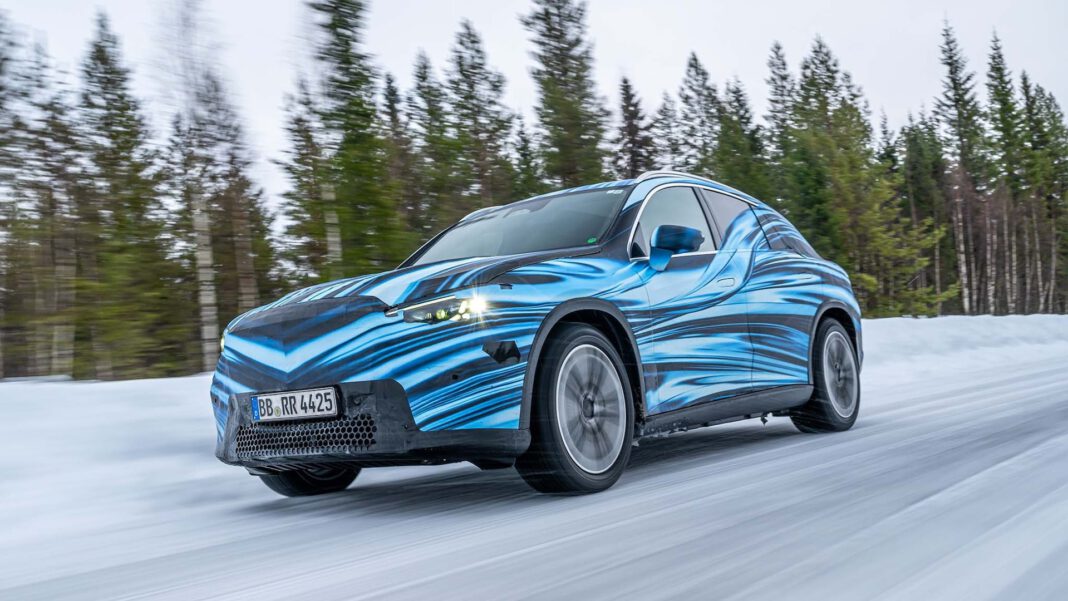The Mercedes-Benz GLC was the three-pointed star’s best-selling vehicle worldwide in 2024. So, it’s perhaps appropriate the GLC-Class has been chosen to debut Mercedes-Benz’s all-new MB.EA electric vehicle architecture, an architecture that will underpin electric powered versions of all future mainstream Mercedes models up to and including the GLS SUV and S-Class sedan. The 2026 Mercedes-Benz GLC with EQ Technology, to give it its full name, is thus a milestone vehicle, the first of a new generation of pure EVs from Mercedes-Benz that promise more performance, more range, and more computer power.
Name and market positioning apart, the electric-powered GLC shares little with its internal combustion engine sibling. Every exterior panel is different, and the roofline is sportier, reportedly helping the electric GLC achieve a drag coefficient of just 0.24. Mercedes-Benz insiders are tight lipped on details until the production car is unveiled in September at the IAA Mobility Show in Munich, but engineers have confirmed the electric GLC has a wheelbase five inches longer than the internal combustion engine model. Most of that extra length has gone into room for the rear set passengers. It really does feel spacious inside.
Unlike the MMA architecture that underpins the forthcoming Mercedes-Benz CLA, the MB.EA architecture has been designed from the wheels up as an EV-only platform. In GLC spec it can be built in two-wheel drive, a single e-motor driving the rear wheels, and in a dual-motor all-wheel drive configuration with system outputs of up to 670 hp. That, coincidentally, is precisely the power produced by the insanely complex plug-in hybrid powertrain of the current Mercedes-AMG GLC63 S E Performance.
MB.EA is a software defined vehicle architecture, with Mercedes-Benz’s new MB.OS operating system overseeing all vehicle functions. Top-spec GLCs will be available in certain markets with LIDAR and have Level 3 autonomous drive capability. A new heat-pump system warms the cabin using just one-third the energy of a traditional HVAC setup. Available hardware upgrades include air suspension and rear-wheel steering.
The GLC will be available with different batteries, ranging from a lithium-iron phosphate battery that on Europe’s WLPT test cycle is likely to deliver up to almost 300 miles of range (which suggests an EPA rating of about 225 miles) to a 94.5-kWh nickel manganese cobalt battery that increases the WLTP-rated range to just over 500 miles (or about 375 miles on the EPA test). High-efficiency silicon carbide anodes that allow a peak charge rate of 320 kW mean the battery can be topped up to give 260 miles more range in as little as 15 minutes.
We had the opportunity to drive an electric GLC 4Matic prototype on roads and snowy forest trails outside Arjeplog, Sweden, right near the Arctic Circle and close to Mercedes-Benz’s winter test center. In terms of powertrain and chassis options, the prototype was reasonably close to what is likely to be the top-spec non-AMG electric GLC 4Matic available in the U.S. It had a dual-motor powertrain with a total system output of 483 hp, the 94.5-kWh battery, air suspension, and rear-wheel steering. It rolled on 20-inch wheels shod with Pirelli Winter 2 tires, 235/50 up front and 265/45 at the rear.
You expect electric vehicles to be quiet, but the electric GLC is impressively silent, road and wind noise very well suppressed and not even a hint of a whine from the e-motors. It wafts down the road like a limousine. The steering is light and direct, enabling you to place the Mercedes on the road with effortless accuracy. The electric GLC has the new Mercedes-Benz digital brake control system, a sophisticated brake-by-wire setup which decouples the brake pedal from the mechanical brake system unless there’s an electronic glitch, in which case a valve enables full hydraulic braking.
As with most EV brake systems, braking up to 0.3 g is done entirely by way of regen. The new Mercedes brake control system makes the handover from regen to mechanical braking under heavy braking utterly seamless, and allows regen to occur even when the ABS kicks in. What’s more, the system’s software delivers a confident and consistent feeling brake pedal under all circumstances.
Four levels of lift-off regen are available: D Auto, which lets the electric GLC’s software optimize the regen levels; D , which allows it to coast; D, which slows it in much the same way as when lifting off the gas in an internal combustion engine vehicle; and D-, which allows one-pedal driving, and will even bring the Mercedes to a halt on an icy downhill. Toggling between the modes is achieved by pushing or pulling the column-mounted shift lever.
The e-motors in the GLC electric are both permanently excited magnet units, the rear one developed entirely in-house by Mercedes and equipped with a two-speed transmission that enables higher road speeds. Some automakers, most notably Volkswagen Group, use less powerful, magnet-free asynchronous motors on the front axle of their dual-motor powertrains because they spin more freely under light loads. Mercedes gets around this issue by actively decoupling the front axle e-motor when it’s not needed.
In Comfort mode, the rear wheels handle 100 percent of the torque, a dog clutch engaging the front motor when the powertrain senses hard acceleration or a loss of traction, or when the front motor is needed for regen. Selecting Sport mode—which, as in the new electric CLA sedan, is done by way of a button on the center console that forces you to toggle through all the modes until you get the one you want—sets up a 33-percent front, 67-percent rear torque split. Terrain mode ups that to 50/50 for ultimate off-road traction.
Pay very close attention and you can feel it takes a fraction of a second for the front wheels to hook up under hard acceleration on snowy surfaces in Comfort mode. In Sport mode, though, the front axle traction is immediate. Regardless of mode, the GLC electric effortlessly motored along snowy mountain trails during our time behind the wheel, highlighting the speed and precision with which torque outputs from e-motors can be modulated to deliver maximum traction. And with 483 hp on tap, it certainly feels punchy on the road.
Stuttgart insiders like to describe the GLC as “the Mercedes-Benz that can do anything”, the best all-rounder in the company’s lineup. And when it came to creating an electric powered GLC, says Christoph Starzynski, head of product strategy at Mercedes-Benz, the company didn’t want to compromise. Indeed, at first acquaintance the GLC electric makes a better GLC than the internal combustion engine model. It’s smoother and quieter, roomier inside, and more effortlessly capable on and off the road.
But the Mercedes-Benz GLC with EQ Technology needs to be good: Vehicles like the Xpeng G6, an SUV that will compete with the electric GLC in many markets, show that China’s automakers are rapidly getting closer and closer to building products that genuinely rival the world’s best.







